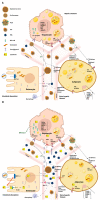To Boost or to Reset: The Role of Lactoferrin in Energy Metabolism
- PMID: 37958908
- PMCID: PMC10650157
- DOI: 10.3390/ijms242115925
To Boost or to Reset: The Role of Lactoferrin in Energy Metabolism
Abstract
Many pathological conditions, including obesity, diabetes, hypertension, heart disease, and cancer, are associated with abnormal metabolic states. The progressive loss of metabolic control is commonly characterized by insulin resistance, atherogenic dyslipidemia, inflammation, central obesity, and hypertension, a cluster of metabolic dysregulations usually referred to as the "metabolic syndrome". Recently, nutraceuticals have gained attention for the generalized perception that natural substances may be synonymous with health and balance, thus becoming favorable candidates for the adjuvant treatment of metabolic dysregulations. Among nutraceutical proteins, lactoferrin (Lf), an iron-binding glycoprotein of the innate immune system, has been widely recognized for its multifaceted activities and high tolerance. As this review shows, Lf can exert a dual role in human metabolism, either boosting or resetting it under physiological and pathological conditions, respectively. Lf consumption is safe and is associated with several benefits for human health, including the promotion of oral and gastrointestinal homeostasis, control of glucose and lipid metabolism, reduction of systemic inflammation, and regulation of iron absorption and balance. Overall, Lf can be recommended as a promising natural, completely non-toxic adjuvant for application as a long-term prophylaxis in the therapy for metabolic disorders, such as insulin resistance/type II diabetes and the metabolic syndrome.
Keywords: glucose metabolism; iron metabolism; lactoferrin; lipid metabolism; metabolic syndrome.
Conflict of interest statement
The authors declare no conflict of interest.
Figures


Similar articles
-
Role of lactoferrin and its derived peptides in metabolic syndrome treatment.Front Endocrinol (Lausanne). 2025 Apr 17;16:1562653. doi: 10.3389/fendo.2025.1562653. eCollection 2025. Front Endocrinol (Lausanne). 2025. PMID: 40313489 Free PMC article. Review.
-
[A remedy against obesity? The role of lactoferrin in the metabolism of glucose and lipids].Postepy Hig Med Dosw (Online). 2012 Nov 22;66:937-53. doi: 10.5604/17322693.1021110. Postepy Hig Med Dosw (Online). 2012. PMID: 23175349 Review. Polish.
-
Lactoferrin in Aseptic and Septic Inflammation.Molecules. 2019 Apr 3;24(7):1323. doi: 10.3390/molecules24071323. Molecules. 2019. PMID: 30987256 Free PMC article. Review.
-
[The role of lactoferrin in the iron metabolism. Part II. Antimicrobial and antiinflammatory effect of lactoferrin by chelation of iron].Postepy Hig Med Dosw (Online). 2010 Nov 30;64:604-16. Postepy Hig Med Dosw (Online). 2010. PMID: 21160095 Review. Polish.
-
Lactoferrin improves hepatic insulin resistance and pancreatic dysfunction in high-fat diet and streptozotocin-induced diabetic mice.Nutr Res. 2022 Jul;103:47-58. doi: 10.1016/j.nutres.2022.03.011. Epub 2022 Mar 27. Nutr Res. 2022. PMID: 35477124
Cited by
-
Exploring the Role of Lactoferrin in Managing Allergic Airway Diseases among Children: Unrevealing a Potential Breakthrough.Nutrients. 2024 Jun 17;16(12):1906. doi: 10.3390/nu16121906. Nutrients. 2024. PMID: 38931261 Free PMC article. Review.
-
Role of lactoferrin and its derived peptides in metabolic syndrome treatment.Front Endocrinol (Lausanne). 2025 Apr 17;16:1562653. doi: 10.3389/fendo.2025.1562653. eCollection 2025. Front Endocrinol (Lausanne). 2025. PMID: 40313489 Free PMC article. Review.
-
Four-Week GLP Immunotoxicity Assessment of Lactoferrin Alpha Produced by Komagataella phaffii in Sprague-Dawley Rats.Int J Toxicol. 2025 Mar-Apr;44(2):125-140. doi: 10.1177/10915818241299344. Epub 2024 Nov 13. Int J Toxicol. 2025. PMID: 39537148 Free PMC article.
-
Towards Clinical Development of Scandium Radioisotope Complexes for Use in Nuclear Medicine: Encouraging Prospects with the Chelator 1,4,7,10-Tetraazacyclododecane-1,4,7,10-tetraacetic Acid (DOTA) and Its Analogues.Int J Mol Sci. 2024 May 29;25(11):5954. doi: 10.3390/ijms25115954. Int J Mol Sci. 2024. PMID: 38892142 Free PMC article. Review.
-
Lactoferrin-A Regulator of Iron Homeostasis and Its Implications in Cancer.Molecules. 2025 Mar 28;30(7):1507. doi: 10.3390/molecules30071507. Molecules. 2025. PMID: 40286136 Free PMC article. Review.
References
-
- Sorensen M., Sorensen S.P.L. The proteins in whey. Comptes Rendus Trav. Lab. Carlsberg Série Chim. 1940;23:55–99.
-
- Johanson B., Virtanen A.I., Tweit R.C., Dodson R.M. Isolation of an Iron-Containing Red Protein from Human Milk. Acta Chem. Scand. 1960;14:510–512. doi: 10.3891/acta.chem.scand.14-0510. - DOI
Publication types
MeSH terms
Substances
LinkOut - more resources
Full Text Sources
Medical
Research Materials

